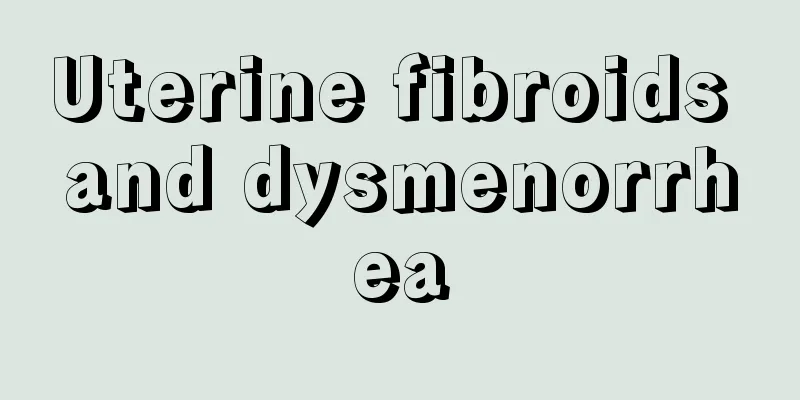Uterine fibroids and dysmenorrhea

|
Uterine fibroids and dysmenorrhea are relatively common in our lives. Because dysmenorrhea is a complication of menstruation, it is caused by cold body and cold uterus. It is recommended that everyone should understand the methods to relieve dysmenorrhea. For the treatment of dysmenorrhea, we generally pay more attention to rest and foot soaking. Uterine fibroids need to be removed surgically, which can also cause symptoms of dysmenorrhea. Can uterine fibroids cause dysmenorrhea? Most patients with uterine fibroids have no obvious symptoms. Uterine fibroids may cause dysmenorrhea, but the pain is generally not too severe. At the same time, uterine fibroids themselves will not cause pain, but if the uterine fibroids are large and have compression symptoms, such as compression of the pelvic floor nerves, patients with uterine fibroids will experience lower abdominal distension and pain; submucosal uterine fibroids can cause uterine contractions and produce dysmenorrhea. Symptoms of uterine fibroids 1. Symptoms Most patients are asymptomatic and the disease is only discovered occasionally during pelvic examination or ultrasound. If there are symptoms, they are closely related to the location, speed, degeneration and complications of the tumor growth, but have relatively little to do with the size and number of the tumor. People with multiple subserosal fibroids may not have symptoms, but a small submucosal fibroid can often cause irregular vaginal bleeding or menorrhagia. Common clinical symptoms include: (1) Uterine bleeding is the most common symptom of uterine fibroids, occurring in more than half of patients. Among them, cyclical bleeding is the most common, which can manifest as increased menstrual volume, prolonged menstrual period or shortened cycle. It may also present as irregular vaginal bleeding that is not related to the menstrual cycle. Uterine bleeding is more common with submucosal fibroids and intramural fibroids, while subserosal fibroids rarely cause uterine bleeding. (2) Abdominal masses and compression symptoms When the fibroids gradually grow and cause the uterus to enlarge to more than the size of a 3-month pregnant uterus or become a large subserosal fibroid located at the fundus of the uterus, a mass can often be felt in the abdomen, which is more obvious in the early morning when the bladder is full. The mass was solid, movable, and non-tender. When the fibroids grow to a certain size, they can cause compression symptoms of surrounding organs. Fibroids on the anterior wall of the uterus close to the bladder can cause frequent urination and urgency; giant cervical fibroids compressing the bladder can cause difficulty in urination or even urinary retention; fibroids on the posterior wall of the uterus, especially those in the isthmus or posterior lip of the cervix, can compress the rectum, causing difficulty in defecation and discomfort after defecation; giant broad ligament fibroids can compress the ureter and even cause hydronephrosis. (3) Pain: Uterine fibroids generally do not cause pain, but many patients may complain of a feeling of heaviness in the lower abdomen and pain in the waist and back. When the pedicle of subserosal fibroids is twisted or uterine fibroids undergo red degeneration, acute abdominal pain may occur. It is not uncommon for fibroids to be combined with endometriosis or adenomyosis, which may cause dysmenorrhea. (4) Increased leucorrhea. Enlargement of the uterine cavity, increase in endometrial glands, and pelvic congestion can cause increased leucorrhea. When submucosal fibroids of the uterus or cervix ulcerate, become infected, or necrotic, bloody or purulent leucorrhea will be produced. (5) Infertility and miscarriage Some patients with uterine fibroids are infertile or prone to miscarriage. The impact on conception and pregnancy outcomes may be related to the growth location, size and number of the fibroids. Giant uterine fibroids can cause deformation of the uterine cavity, hindering the implantation of the gestational sac and the growth and development of the embryo; fibroids compressing the fallopian tubes can lead to obstruction of the lumen; submucosal fibroids can hinder the implantation of the gestational sac or affect the entry of sperm into the uterine cavity. The spontaneous abortion rate in patients with fibroids is higher than that in the normal population, with a ratio of about 4:1. (6) Anemia: Long-term menorrhagia or irregular vaginal bleeding may cause hemorrhagic anemia. More severe anemia is more common in patients with submucosal fibroids. (7) A very small number of patients with uterine fibroids may develop polycythemia and hypoglycemia, which are generally believed to be related to the production of ectopic hormones by the tumor. |
<<: What to do if breasts become swollen, painful and hard
>>: Breastfeeding nipples are hard and a little painful
Recommend
Can I drink yogurt if I have breast hyperplasia?
Speaking of the disease of breast hyperplasia, ma...
What is the process of natural abortion?
In today's society, the body is severely dama...
How to treat white tongue coating in pregnant women
Many pregnant women will encounter some minor phy...
What are the benefits of drinking sweet wine for women
In today's life, there are so many kinds of f...
What are the symptoms of chocolate cysts?
The occurrence of chocolate cysts can cause patie...
What is the body temperature of women during ovulation?
Many women know that they can use body temperatur...
Is the baby a boy or a girl?
Nowadays, many pregnant mothers go to the hospita...
The scientific method of having a son
Although the idea of favoring sons over daughte...
Is BV positive related to men?
If the flora in a woman's vagina is unbalance...
What color hair should girls with dark skin dye to make their hair look whiter
There are many factors that lead to dark skin. No...
What are the reasons why menstruation has not come for 14 days?
In life, women often have delayed menstruation du...
Is calf cramps in pregnant women due to calcium deficiency?
Many adolescent boys and girls often experience c...
How long does it take for breast swelling to occur during pregnancy?
In fact, in daily life, many people do not have t...
Can I eat Oreo cookies while breastfeeding?
You should be careful when eating Oreos while bre...
Attention: These people cannot eat donkey-hide gelatin cake
Donkey-hide gelatin is a holy product for repleni...









